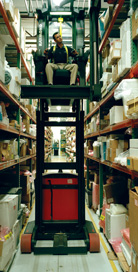 By Ian Hobkirk
By Ian Hobkirk
Managing Director of Commonwealth Supply Chain Advisors
As the global economy continues its recovery, many distribution centers are bursting at the seams and out of space. When expanding the footprint of the warehouse is not an option, companies often employ creative techniques such as using narrower aisles to improve space utilization.
The most common form of lift truck in use in North American distribution centers is the Reach Truck. Developed in the 1950’s, this lift truck is capable of operating in aisles as narrow as 8 ½ feet, although the most common layout utilizes aisles of 9 ½ feet to allow for faster operation and less damage.
In an effort to reduce space requirements, many companies have employed Very Narrow Aisle, or “VNA” lift truck technology. VNA turret trucks are capable of operating in aisles as narrow as 5 ½ feet (Figure 1), while Order Picker vehicles can operate in even smaller aisles. Given the potential for space savings, it can be tempting to redesign a distribution center to utilize this equipment, however, careful thought must go into the design to ensure an effective operation.
A few key design considerations when designing a distribution center with Vary Narrow Aisle Rack are listed below.
1. Columns matter! Calculate space savings based on actual layout: There are a number of reasonably accurate space savings calculator tools which can quickly determine how much space can be reduced by converting from a traditional layout to a VNA layout. These tools are usually based on the assumption that the column positions in the building are perfectly spaced to fall in the flue spaces of a rack system, which is often not the case. While such tools can provide a good general idea of possible space savings, actual savings cannot be determined until a detailed layout with columns is created. In a VNA system, the aisles must all be exactly the same width. Aisles cannot be flexed wider or narrower to accommodate column positions. Any variance based on the column grid must be made up by adjusting the flue spacing, or using single rows of rack. In some cases, these adjustments can result in significant reductions in storage capacity which must be factored into any ROI calculations.
2. Don’t go narrower than 5 ½ feet: As noted earlier, Order Picker vehicles are capable of operating in aisles which are even narrower than 5 ½ feet, and some facility designers, eager to squeeze every inch of aisle space out of the layout, have utilized ultra-narrow aisles. However, in most cases, aisles narrower than 5 ½ feet will require that all product put into, or taken out of the rack be done so by hand – hand stacking cases of product on decked shelves. Pallet-handling turret trucks require a full 5 ½ feet of clear space (including pallet overhang) to operate in. While this is a few inches larger than the smallest Order Picker aisle, the additional ability to simply put away full pallets without having to hand stack is almost always worth it. Business needs change over time, and it is best to design a sufficient amount of flexibility into the system. (Note: “swing mast” style trucks and articulating lift trucks are sometimes capable of operating in aisles that are less than 5 ½ feet wide, but numerous other drawbacks generally make these trucks unsuitable for high-speed distribution operations).
3. Avoid congestion: Use VNA sparingly: A key trade-off with VNA rack is that two vehicles are not able to pass in the same aisle. For this reason, using VNA aisles in a high-volume forward picking operation can often be problematic. If multiple pickers need to access the same aisle at the same time, some of them will have to either wait, or skip the aisle and come back to it later. This can significantly diminish productivity. While some companies have customized their WMS systems to help prevent instances of aisle contention, this functionality is surprisingly rare. A better suggestion is to try to confine the VNA area to overstock only, where vehicles will pick product that is to be used to replenish the forward pick area. Replenishment volume is almost always lower than pick volume, and is often less time sensitive. For these reasons, aisle congestion is usually less of an issue in overstock areas. One potential strategy is for an operation to convert floor-level picking to multi-level picking in standard aisles (9 ½ feet), and then have a separate overstock area using VNA aisles.

